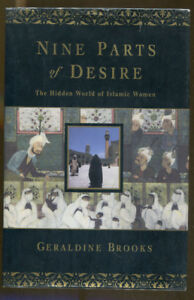Given that this book was written in 1995, (reprinted in 2008 with a new afterword) I hoped that her analysis of the lives of Islamic Women in Middle East countries might have been rendered redundant. That hope has not been realized. Despite the Arab Spring, the position of women in Islamic countries remains parlous, and possibly even worse than when Brooks wrote this book prior to 9/11, the rise of ISIS and the wars that followed in its wake.
Geraldine Brooks, who was born in Australia, worked as a journalist and foreign correspondent for many years, although she is probably better known now for her historical fiction. While she was working as the Middle East bureau chief for the Wall Street Journal, she was frustrated by the customs that made her life as a journalist so difficult, compared with her male fellow journalists. Then she noted that her colleague and translator, Sahar, had begun wearing the hijab. Curious about why Sahar had adopted it, she realized that as a woman she had access to women’s experience that was closed to male journalists.
For almost a year I fretted and kicked at the Middle East’s closed doors. Then, thanks to Sahar, I looked up and noticed the window that was open only to me.
p. 7 1995 edition
Taking on Islamic dress herself, she sought out women who were still working as journalists, politicians and activists. Many women told her that, historically, Islam provided an improvement on women’s conditions, that the Prophet himself was pro-women, and that Islamic dress provided a respite from the male gaze. She was not convinced:
Once I began working on this book, I looked everywhere for examples of women trying to reclaim Islam’s positive messages, trying to carry forward into the twentieth century the reformist zeal with which Muhammad had remade the lives of many women (other than his own wives and the Muslim army’s war captives) in the first Muslim community at Medina. It turned out to be a frustrating search. In most places the direction of the debate seemed to be exactly the reverse. Palestinian, Egyptian, Algerian and Afghani women were seeing a curtain come down on decades of women’s liberation as Islamic leaders in their countries turned to the most exclusionary and inequitable interpretations. For those women who struggled against the tide, the results were a discouraging trio of marginalization, harassment and exile.
p. 232, 1995 edition
The title of the book is taken from a quote from Ali ibn Abu Taleb, the husband of Muhammad’s daughter Fatima and the founder of the Shiite sect of Islam. “Almighty God created sexual desire in ten parts; then he gave nine parts to women and one to men”. This sounds like an invitation to male lasciviousness to me, and the desires that Brooks explores in this book are not sexual. Each chapter starts with a relevant quote from the Koran.
Chapter 1, The Holy Veil talks about Brooks’ own interview with Hashemi Rafsanjani, who was President of Iran between 1989-1997, for which Brooks wore the chador. She writes about the variations of Islamic dress in different Middle East countries, and the effect of Iran’s theocratic revolution. Chapter 2 “Whom No Man Shall Have Deflowered Before Them” discusses female genital mutilation and its absence in the Koran itself, honour killing, and the paradox between sexual licence for men and repression for women. Chapter 3 “Here Come the Brides” looks at Islamic marriage while Chapter 4 “The Prophet’s Women” looks at Muhammad’s own family life, making the point that many of the revelations from God seemed to be particularly apposite for Muhammad’s own situation. Chapter 5 “Converts” focuses on Janet, an American who had married and converted to Islam, and Janet’s American friend Margaret. Both women complied completely with the demands of their husband and in-laws. Chapter 6 “Jihad is for Women, Too” looks at the paradox of women incorporated into the military forces in Islamic countries, and the empowerment (within limits) that this sometimes provided. Chapter 7 “A Queen” looks at the situation of the American-born Queen Noor of Jordan, a country that at the time offered the most hope for political liberalism. Chapter 8 “The Getting of Wisdom” examines women’s education in different Middle East countries, with differing degrees of segregation and the increasing presence of fundamentalism. Chapter 9 “Risky Business” looks at women’s role in the workforce, and Chapter 10 “Politics, With and Without a Vote” looks at the varied (and decreasing) political roles available to women. Ironically, some Islamic women were elected in hard-line Iran, but I sense that her political acceptability was increased by her persecution under the Shah which made her a striking example of the repressiveness of pro-Western politics. She picks up on the campaign by Saudi women to be able to drive- something that is shamefully still a travesty. Chapter 11 “Muslim Women’s Games” addresses the women-only Islamic Women’s Games and in Chapter 11 “A Different Drummer” Brooks herself gets physical by taking a belly-dancing course.
In her conclusion “Beware of the Dogma” she comes out most strongly with her own conclusions and the question of how we, as Europeans, should respond. She argues that “In an era of cultural sensitivity, we need to say that certain cultural baggage is contraband in our countries and will not be admitted.” (p.238) At the time of writing, America did not have laws banning female genital mutilation (Australia does). She argues – but does not believe that it will ever be accepted – that Islamic women should have a right to asylum on the grounds of “well-founded fear of persecution” as a matter of course.
I have read this book before, and I think that I am even more conscious of the issues that she raises, especially after the Arab Spring sputtered out. Her criticism is most strongly directed at Saudi Arabia, a country which has assumed even more importance on the world stage since Trump. She is strong in her condemnation, especially in her conclusion, but she avoids the reflexive Islamophobia of, say, Ayan Hirsi Ali (who lost me with her association with the American Enterprise Institute). Her interviews mainly deal with middle-class and educated women, but that probably reflects the milieu in which she was working and the contacts that she made. She seems rather oblivious to the effect that her Judaism – something that she does not hide- may have had on her informants.
My rating: 8/10
Sourced from: CAE Book Groups.
I have included this on the Australian Women Writers Challenge Database.



Pingback: Non-Fiction (General) Round Up: February 2021 | Australian Women Writers Challenge Blog
I have often wondered about re-reading this book too Janine because I remember finding it an interesting discussion of the issue.
I remember also thinking that the subtitle was a little of a misnomer because, particularly back then, there were many many Islamic women in southeast Asia who were not “hidden” like their Middle-eastern counterparts. I think it’s still the case, though there is an increasing move to the right there now I believe.
I must say, with all the stuff going on here recently I have been starting to rethink the validity of the “male gaze” argument even if I don’t really want us to go there!
Pingback: Australian Women Writers Challenge 2021 | The Resident Judge of Port Phillip